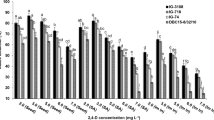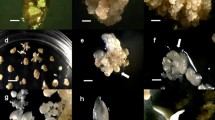Abstract
In this study, we have demonstrated that Zoysia japonica callus induced from mature seeds can produce high frequencies of plant regeneration and somatic embryogenesis, even following a prolonged period of subculturing. Initial callus cultures were induced from mature seeds of Japanese lawngrass (Z. japonica Steud.) incubated on a medium containing major N6 medium salts, minor Murashige and Skoog (MS) medium salts, and modified MS medium organic elements supplemented with 3 mg L−1 2,4-dichlorophenoxyacetic acid (2,4-D) and 0.01–0.02 mg L−1 6-benzyladenine. Compact callus were selected and subcultured monthly on a medium containing 2 mg L−1 2,4-D, 0.5 mg L−1 kinetin, 500 mg L−1 casein hydrolysate, 500 mg L−1 proline, and 500 mg L−1 myoinositol. Callus maintained in vitro for 18 mo could be induced to regenerate plantlets with a frequency of >90%. By contrast, 36-mo-old callus cultures failed to produce normal shoot regeneration. However, the addition of CuSO4 to the subculture media maintained >90% regeneration frequencies in such long-term callus cultures. Histological observations revealed that plant regeneration occurred both through somatic embryogenesis and organogenesis pathways. The ability to sustainable regeneration in long-term callus cultures will be valuable to the program of genetic transformation and somaclonal variant selection.



Similar content being viewed by others
References
Al-Khayri J. M.; Huang F. H.; Thompson L. F.; King J. W. Plant regeneration of Zoysiagrass from embryo-derived callus. Crop Sci. 29 (5): 1324–1325; 1989.
Asano Y. Somatic embryogenesis and protoplast culture in Japanese lawngrass (Zoysia japonica). Plant Cell Rep. 8 (3): 141–143; 1989.
Borchert T.; Fuchs J.; Winkelmann T.; Hohe A. Variable DNA content of Cyclamen persicum regenerated via somatic embryogenesis: rethinking the concept of long-term callus and suspension cultures. Plant Cell Tissue Organ Cult. 90 (3): 255–263; 2007.
Chaudhury A.; Qu R. D. Somatic embryogenesis and plant regeneration of turf-type bermudagrass: effect of 6-benzyladenine in callus induction medium. Plant Cell Tissue Organ Cult. 60: 113–120; 2000.
Corredoira E.; Vieitez A. M.; Ballester A. Somatic embryogenesis in Elm. Ann. Bot. 89: 637–644; 2002.
Hao Y. J.; Deng X. X. Occurrence of chromosomal variations and plant regeneration from long-term-cultured citrus callus. In Vitro Cell. Dev. Biol. Plant 38: 472–476; 2002.
Hasegawa H.; Sato M.; Suzuki M. Efficient plant regeneration from protoplasts isolated from long-term; shoot primordia-derived calluses of garlic (Allium sativum). J. Plant Physiol. 159 (4): 449–452; 2002.
Inokuma C.; Sugiura K.; Cho C.; Okawara R.; Kaneko S. Plant regeneration from protoplasts of Japanese lawngrass. Plant Cell Rep. 15: 737–741; 1996.
Kim S. W.; Oh S. C.; Liu J. R. Control of direct and indirect somatic embryogenesis by exogenous growth regulators in immature zygotic embryo cultures of rose. Plant Cell Tissue Organ Cult. 74: 61–66; 2003.
Kothari S. L.; Agarwal K.; Kumar S. Inorganic nutrient manipulation for highly improved in vitro plant regeneration in finger millet—Eleusine coracana (L.) Gaertn. In Vitro Cell. Dev. Biol. Plant 40: 515–519; 2004.
Li R. F.; Wei J. H.; Wang H. Z.; He J.; Sun Z. Y. Development of highly regenerable callus lines and Agrobacterium-mediated transformation of Chinese lawngrass (Zoysia sinica Hance) with a cold inducible transcription factor, CBF1. Plant Cell Tissue Organ Cult. 85(3): 297–305; 2006.
Limei G.; Xu Z.; Zhang Y.; Huang X.; Liu Y. Studies on tissue culture and regeneration system of Festuca arundinacea and transient expression of GUS gene. Acta Botanica Boreali—Occidentalia Sinica 25 (1): 40–45; 2005.
Liu J. H.; Shi J. C. Studies on selection of valuable somaclonal mutants in silage maize. Acta Bot. Sin. 38 (10): 839–842; 1996.
Motoike S. Y.; Skirvin R. M.; Norton M. A.; Otterbacher A. G. Somatic embryogenesis and long term maintenance of embryogenic lines from fox grapes. Plant Cell Tissue Organ Cult. 66 (2): 121–131; 2001.
Nirwan R. S.; Kothari S. L. High copper levels improve callus induction and plant regeneration in Sorghum bicolor (L.) Moench. In Vitro Cell. Dev. Biol. Plant 39: 161–164; 2003.
Pniewski T.; Kapusta J.; Plucienniczak A. Agrobacterium-mediated transformation of yellow lupin to generate callus tissue producing HBV surface antigen in a long-term culture. J. Appl. Genet. 47 (4): 309–318; 2006.
Pontaroli A. C.; Camadro E. L. Somaclonal variation in Asparagus officinalis plants regenerated by organogenesis from long-term callus cultures. Genet. Mol. Biol. 28 (3): 423–430; 2005.
Purnhauser L.; Gyulai G. Effect of copper on shoot and root regeneration in wheat, triticale, rape and tobacco tissue cultures. Plant Cell Tissue Organ Cult. 35: 131–139; 1993.
Sangthong R.; Mii M.; Soonthornchainaksaeng P.; Supaibulwatana K. Characteristics of the tetraploid plant derived as a somaclonal variation in Lilium longiflorum. Acta Hortic. 673: 167–174; 2005.
Sharma V. K.; Hänsch R.; Mendel R. R.; Schulze J. Influence of picloram and thidiazuron on high frequency plant regeneration in elite cultivars of wheat with long-term retention of morphogenecity using meristematic shoot segments. Plant Breed. 124 (3): 242–246; 2005.
Tahiliani S.; Kothari S. L. Increased copper content of the medium improves plant regeneration from immature embryo derived callus of wheat (Triticum aestivum). J. Plant Biochem. Biotechnol. 13: 85–88; 2004.
Toyama K.; Bae C. H.; Kang J. G.; Lim Y. P.; Adachi T.; Riu K. Z.; Song P. S.; Lee H. Y. Production of herbicide-tolerant Zoysiagrass by Agrobacterium-mediated transformation. Mol. Cells 16 (1): 19–27; 2003.
Zhang L.; Rybczynski J. J.; Langenberg W. G.; Mitra A.; French R. An efficient wheat transformation procedure: transformed calli with long-term morphogenic potential for plant regeneration. Plant Cell Rep. 19 (3): 241–250; 2000.
Acknowledgements
This research was supported by the Ministry of Science and Technology of China, grant number 2004AA244050. Li Liu and Xiaoli Fan contributed equally to this work. We thank Dr. Alex McCormac of UK for the critical editing of the manuscript and all the colleagues in our laboratory for the constructive discussion and technical assistance.
Author information
Authors and Affiliations
Corresponding author
Additional information
Communicatedby
Editor: M. Nakano
Rights and permissions
About this article
Cite this article
Liu, L., Fan, X., Zhang, J. et al. Long-term cultured callus and the effect factor of high-frequency plantlet regeneration and somatic embryogenesis maintenance in Zoysia japonica . In Vitro Cell.Dev.Biol.-Plant 45, 673–680 (2009). https://doi.org/10.1007/s11627-009-9226-6
Received:
Accepted:
Published:
Issue Date:
DOI: https://doi.org/10.1007/s11627-009-9226-6




